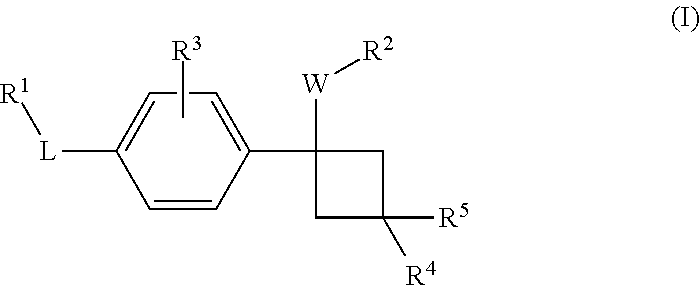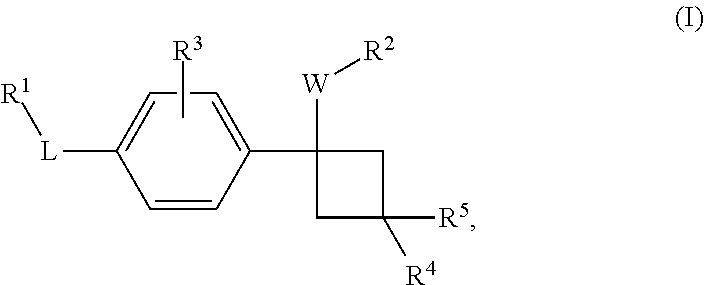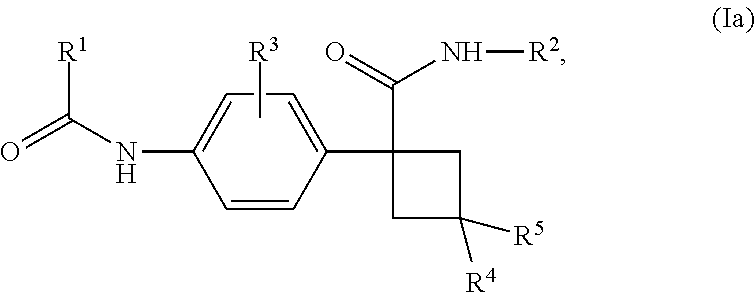Novel substituted cyclobutylbenzene compounds as indoleamine 2,3-dioxygenase (IDO) inhibitors
a technology of indoleamine and cyclobutylbenzene, which is applied in the direction of drug composition, organic chemistry, antineoplastic agents, etc., can solve the problem that the fetus cannot fully explain the survival of the fetal allogra
- Summary
- Abstract
- Description
- Claims
- Application Information
AI Technical Summary
Benefits of technology
Problems solved by technology
Method used
Image
Examples
example 1
utyramidocyclobutyl)phenyl)-3-chlorobenzamide
[0344]
Step 1: Preparation of N-(1-(4-bromophenyl)cyclobutyl)butyramide
[0345]To a vial containing butyric acid (52 μl, 0.57 mmol) and HATU (280 mg, 0.74 mmol) was added DMF (2100 μl). The reaction mixture was allowed to stir at RT for 5 min, before a solution of 1-(4-bromophenyl)cyclobutanamine (150 mg, 0.64 mmol) in DMF (710 μl) was added, followed by DIPEA (350 μl, 2.0 mmol). The reaction mixture was stirred at RT for 5 days, then partitioned between EtOAc and saturated NaHCO3. The organic layer was dried over anhydrous magnesium sulfate, filtered, and concentrated under reduced pressure to afford N-(1-(4-bromophenyl)cyclobutyl)butyramide. MS ESI calc'd. [M+H]+ 296, found 296.
Step 2: Preparation of N-(4-(1-butyramidocyclobutyl)phenyl)-3-chlorobenzamide
[0346]To a vial equipped with a stir bar was added N-(1-(4-bromophenyl)cyclobutyl)butyramide (30 mg, 0.10 mmol), cesium carbonate (99 mg, 0.30 mmol), 3-chlorobenzamide (15 mg, 0.099 mmol), ...
example 2
N-(4-(1-(4-cyanobenzamido)cyclobutyl)phenyl)benzamide
[0347]
Step 1: Preparation of ethyl 1-(4-nitrophenyl)cyclobutanecarboxylate
[0348]To a solution of ethyl 2-(4-nitrophenyl)acetate (9 g, 43 mmol) in DMF (100 mL) was added NaH (3.6 g, 90 mmol) (60% in oil) at 0° C. The reaction mixture was allowed to warm to RT and was stirred for 15 min. The mixture was cooled to 0° C. and 1,3-diiodopropane (10 mL, 89 mmol) was added. The resulting mixture was stirred at 0° C. for 30 min, then warmed to RT. After 1 h the reaction mixture was diluted with aqueous NH4Cl (200 mL), and was extracted with EtOAc (200 mL×3). The combined organics were washed with brine (1000 mL), dried over saturated Na2SO4, filtered and concentrated under reduced pressure. The residue was purified by silica gel chromatography (SiO2, petroleum ether / EtOAc=50:1 to 40:1) to afford ethyl 1-(4-nitrophenyl)cyclobutanecarboxylate.
Step 2: Preparation of 1-(4-nitrophenyl)cyclobutanecarboxylic Acid
[0349]To a solution of ethyl 1-(4-...
example 19
-(4-(1-(4-chlorobenzamido)cyclobutyl)phenyl)benzamide
[0356]
Step 1: Preparation of 1-(4-Nitrophenyl)cyclobutan-1-amine
[0357]A mixture of tert-butyl (1-(4-nitrophenyl)cyclobutyl)carbamate (Intermediate 1) (250 mg, 0.86 mmol) and HCl (4 mL, 16 mmol) (4M in dioxane) was stirred at RT for 2 h, then concentrated under reduced pressure to afford 1-(4-nitrophenyl)cyclobutanamine hydrochloride.
Step 2: Preparation of 4-chloro-N-(1-(4-nitrophenyl)cyclobutyl)benzamide
[0358]To a solution of 1-(4-nitrophenyl)cyclobutanamine hydrochloride (200 mg, 0.86 mmol) in DMF (5 mL) was added HATU (330 mg, 0.87 mmol), 4-chlorobenzoic acid (140 mg, 0.87 mmol) and DIEA (0.6 mL, 3.4 mmol) while stirring at RT. The reaction mixture was allowed to stir for 15 h, and was then diluted with water (30 mL), and extracted with EtOAc (20 mL×3). The combined organics were washed with brine (20 mL), dried over anhydrous Na2SO4, filtered, and concentrated under reduced pressure. The residue was purified by silica column ch...
PUM
| Property | Measurement | Unit |
|---|---|---|
| enantiomeric excess | aaaaa | aaaaa |
| enantiomeric excess | aaaaa | aaaaa |
| enantiomeric excess | aaaaa | aaaaa |
Abstract
Description
Claims
Application Information
 Login to View More
Login to View More - R&D
- Intellectual Property
- Life Sciences
- Materials
- Tech Scout
- Unparalleled Data Quality
- Higher Quality Content
- 60% Fewer Hallucinations
Browse by: Latest US Patents, China's latest patents, Technical Efficacy Thesaurus, Application Domain, Technology Topic, Popular Technical Reports.
© 2025 PatSnap. All rights reserved.Legal|Privacy policy|Modern Slavery Act Transparency Statement|Sitemap|About US| Contact US: help@patsnap.com



